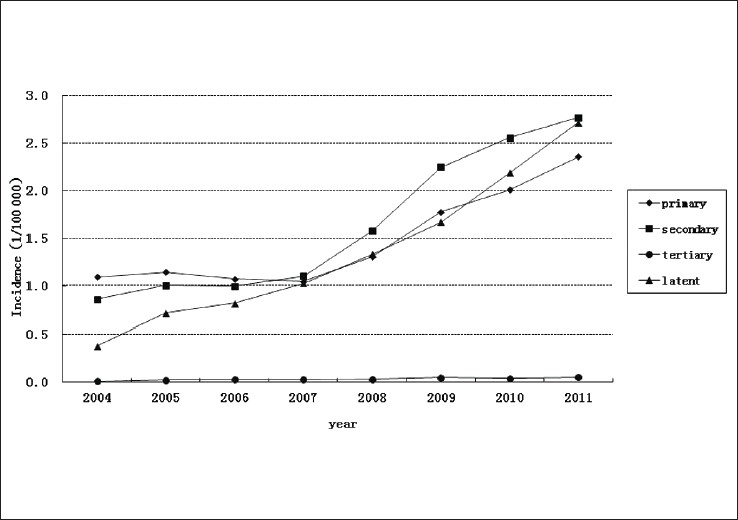Translate this page into:
The syphilis epidemic in Shandong province, China: An analysis based on surveillance data from 2004 to 2011
2 Shandong Provincial Institute of Dermatology and Venereology, Jingshi Lu, Jinan, Shandong, China
Correspondence Address:
Shumin Chen
Department of STD and Leprosy Prevention and Control, Shandong Clinical College of Skin Diseases, Anhui Medical University, 27397, Jingshi Lu, Jinan, Shandong 250022
China
| How to cite this article: Liu D, Chu T, Chen S. The syphilis epidemic in Shandong province, China: An analysis based on surveillance data from 2004 to 2011. Indian J Dermatol Venereol Leprol 2013;79:553 |
Sir,
Since syphilis re-emerged in China in the 1970s, the disease has been spreading widely over the country, with an accelerating speed. [1] Experts have long debated the nature and cause of this syphilis epidemic in China. [2],[3] Tucker et al. confirmed a rapid increase in reported syphilis cases in China. [2] However, Wu et al. concluded that this rapid increase is primarily caused by systematic changes in diagnosis and reporting. [3] In 2004, the independent sexually transmitted disease (STD) reporting system was replaced by the China Information System for Disease Control and Prevention covering all notifiable diseases.
Shandong is one of the most economically developed and the second most populous province in China, with a population of 94 millions. The reported information in China Information System for Disease Control and Prevention has been available to describe the real magnitude of syphilis epidemic in Shandong.
The reported incidence of syphilis in Shandong increased from 2.40 cases/100,000 people in 2004 to 8.19 cases/100,000 people in 2011, showing an average yearly increase of 19.17% [Figure - 1]. The reported incidence of primary, secondary, tertiary and latent syphilis increased from 1.10, 0.86, 0.008 and 0.38 cases per 100,000 people in 2004 to respectively 2.36, 2.77, 0.05 and 2.72 cases per 100,000 people in 2011, showing an average yearly increase of 11.52%, 11.19%, 30.88% and 32.47% respectively [Figure - 2]. The reported incidence of congenital syphilis increased from 4.39 cases/100,000 live births in 2004, 25.88 cases/100,000 live births in 2011, showing an average yearly increase of 28.12% [Figure - 1]. From 2004 to 2011, a total of 35,027 cases of syphilis were reported in Shandong, of which 31.68% were primary cases, 35.24% were secondary cases, 29.15% were latent syphilis cases.
 |
| Figure 1: Reported incidences of syphilis in total and congenital syphilis in Shandong from 2004 to 2011 |
 |
| Figure 2: Reported incidences of primary, secondary, tertiary and latent syphilis in Shandong from 2004 to 2011 |
The reported incidence of early syphilis is a good indicator of syphilis trend in a country. Early syphilis cases are primarily diagnosed and reported by STD clinicians in China. In the years until 2010 health authorities in Shandong have not put extra emphasis on the quality of syphilis diagnosis, screening and reporting by training and supervising STD clinicians. We believe that strengthening of syphilis screening in institutions or departments other than STD clinics may have contributed to the detection of latent syphilis. Based on our surveillance data, we believe that Tucker′s observation is also true for Shandong: syphilis is now a significant problem in this provinces and the yearly incidence figures continue to increase rapidly.
However, the reported incidence of syphilis and the average yearly increase in disease incidence were much lower in Shandong than on the national level. The total reported incidence of syphilis in China increased from 8.71 cases/100,000 people in 2005 to 32.04 cases/100,000 people in 2011, showing a yearly increase of 25.49%. [4],[5] Therefore, we have reason to doubt if the reported incidence of syphilis reflects the real magnitude of the syphilis epidemic in Shandong. Additionally, we reviewed literature on syphilis prevalence among groups in Shandong with different risk behaviors in the years between 2004 and 2011, and no significant difference was found between Shandong and the country overall. There are no good explanations why the incidence figures for syphilis would be lower in Shandong than that in the whole country. Thus, the real magnitude of the syphilis epidemic in Shandong may be underestimated by the reported data.
The poor quality of the case reporting system in Shandong may explain the relatively low syphilis incidence in the province. In our analysis, 50.73% of all reported syphilis cases in the past 7 years were from 3 of the 17 prefectures in Shandong. This may either indicate a higher incidence of syphilis in economically developed cities or the poor quality of case reporting in poorly developed areas. More data are needed to support one or both of the hypotheses.
In summary, the syphilis epidemic is rapidly increasing in Shandong province. The true number of syphilis cases in the province may be underestimated. More efforts should be directed towards improving surveillance, prevention and control of syphilis in Shandong.
| 1. |
Chen ZQ, Zhang GC, Gong XD, Lin C, Gao X, Liang GJ, et al. Syphilis in China: Results of a national surveillance programme. Lancet 2007;369:132-8.
[Google Scholar]
|
| 2. |
Tucker JD, Chen XS, Peeling RW. Syphilis and social upheaval in China. N Engl J Med 2010;362:1658-61.
[Google Scholar]
|
| 3. |
Wu Z, Zhou P. Syphilis and social upheaval in China. N Engl J Med 2010;363:1088.
[Google Scholar]
|
| 4. |
National Center for STD Control, China CDC. National reports of epidemiological data on syphilis and gonorrhea in 2005. Bull STI Prev Control 2006;203:2-12.
[Google Scholar]
|
| 5. |
National Center for STD Control, China CDC. National reports of epidemiological data on syphilis and gonorrhea in 2011. Bull STI Prev Control 2011;258:9-19.
[Google Scholar]
|
Fulltext Views
2,016
PDF downloads
1,637





